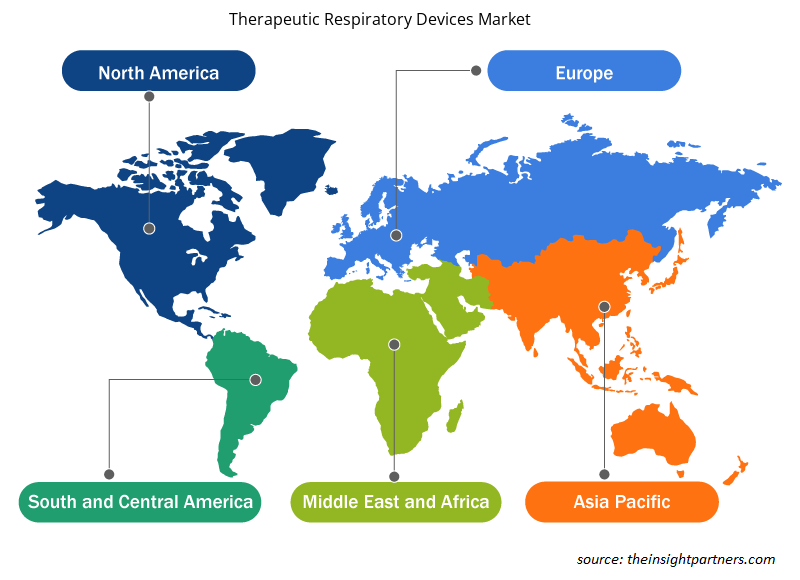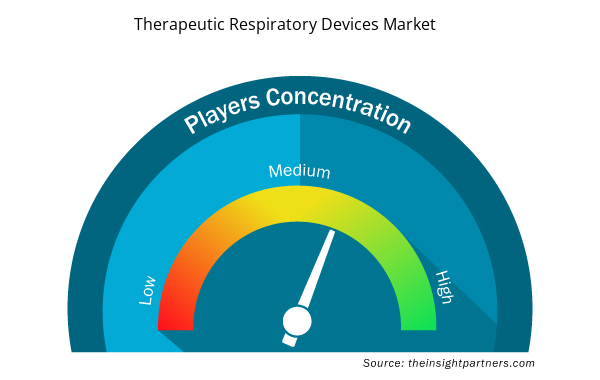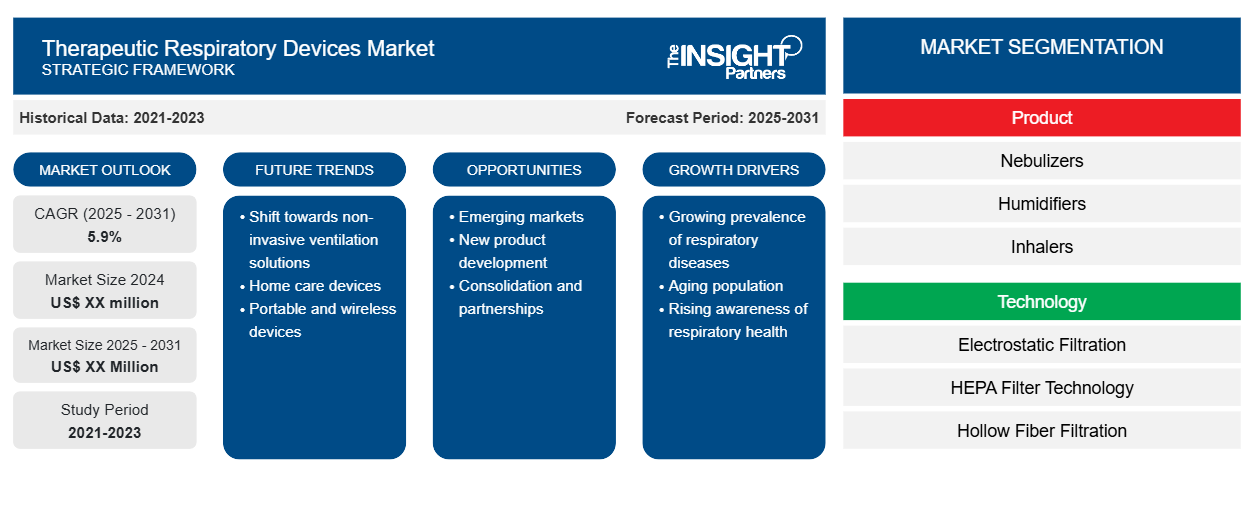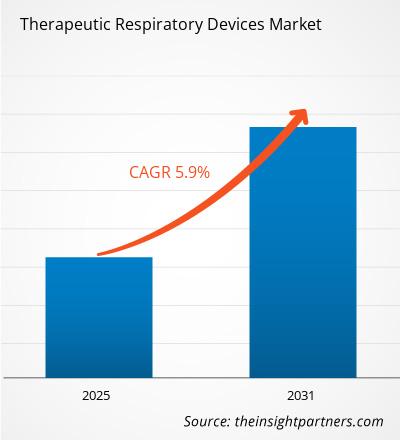Le marché des appareils respiratoires thérapeutiques devrait enregistrer un TCAC de 5,9 % de 2024 à 2031, avec une taille de marché passant de XX millions USD en 2024 à XX millions USD d'ici 2031.
Le rapport est segmenté par produit (nébuliseurs, humidificateurs, inhalateurs, concentrateurs d'oxygène, appareils à pression positive continue, ventilateurs, capnographes, analyseurs de gaz et autres) ; technologie (filtration électrostatique, technologie de filtre HEPA, filtration à fibres creuses et séparation de microsphères), filtres (filtres pour nébuliseurs, filtres pour humidificateurs, filtres pour appareils à pression positive continue, filtres pour concentrateurs d'oxygène et filtres pour ventilateurs)
Objectif du rapport
Le rapport sur le marché des appareils respiratoires thérapeutiques de The Insight Partners vise à décrire le paysage actuel et la croissance future, les principaux facteurs moteurs, les défis et les opportunités. Cela fournira des informations à diverses parties prenantes commerciales, telles que :
- Fournisseurs/fabricants de technologie : pour comprendre l’évolution de la dynamique du marché et connaître les opportunités de croissance potentielles, leur permettant de prendre des décisions stratégiques éclairées.
- Investisseurs : Effectuer une analyse complète des tendances concernant le taux de croissance du marché, les projections financières du marché et les opportunités qui existent tout au long de la chaîne de valeur.
- Organismes de réglementation : Réglementer les politiques et surveiller les activités du marché dans le but de minimiser les abus, de préserver la confiance des investisseurs et de maintenir l’intégrité et la stabilité du marché.
Segmentation du marché des dispositifs respiratoires thérapeutiques
Produit
- Nébuliseurs
- Humidificateurs
- Inhalateurs
- Concentrateurs d'oxygène
- Dispositifs de pression positive continue
- Ventilateurs
- Capnographes
- Analyseurs de gaz
- Autres
Technologie
- Filtration électrostatique
- Technologie de filtre HEPA
- Filtration à fibres creuses
- Séparation des microsphères
Filtres
- Filtres pour nébuliseurs
- Filtres pour humidificateur
- Filtres pour appareils à pression positive des voies respiratoires
- Filtres concentrateurs d'oxygène
- Filtres de ventilateur
Géographie
- Amérique du Nord
- Europe
- Asie-Pacifique
- Amérique du Sud et Amérique centrale
- Moyen-Orient et Afrique
Personnalisez ce rapport en fonction de vos besoins
Vous bénéficierez d'une personnalisation gratuite de n'importe quel rapport, y compris de certaines parties de ce rapport, d'une analyse au niveau des pays, d'un pack de données Excel, ainsi que de superbes offres et réductions pour les start-ups et les universités.
- Obtenez les principales tendances clés du marché de ce rapport.Cet échantillon GRATUIT comprendra une analyse de données, allant des tendances du marché aux estimations et prévisions.
Facteurs de croissance du marché des dispositifs respiratoires thérapeutiques
- Prévalence croissante des maladies respiratoires :
- L'incidence croissante des maladies respiratoires, telles que la bronchopneumopathie chronique obstructive (BPCO), la bronchite chronique et l'asthme, va stimuler le marché des appareils respiratoires thérapeutiques. L'Organisation mondiale de la santé rapporte que la BPCO est responsable de trois millions de décès par an, ce qui en fait la troisième cause de mortalité la plus mortelle dans le monde, avec environ 65 millions de personnes souffrant de cette maladie. L'incidence croissante des maladies respiratoires devrait stimuler ce marché.
- Vieillissement de la population :
- L’autre facteur stimulant majeur pour le marché des appareils respiratoires thérapeutiques est le facteur âge. En vieillissant, les personnes ont tendance à souffrir davantage de maladies pulmonaires telles que la BPCO, qui peut éventuellement provoquer une insuffisance respiratoire chronique. On estime que près de 1,5 milliard de personnes auront 65 ans et plus en 2050, et que ces personnes auront donc besoin d’appareils respiratoires thérapeutiques pour une meilleure gestion des maladies respiratoires chroniques.
- Sensibilisation croissante à la santé respiratoire :
- La sensibilisation croissante des personnes à la santé respiratoire stimule également le marché des appareils respiratoires thérapeutiques. La prise de conscience de la santé pulmonaire et la nécessité de détecter les maladies à un stade précoce incitent à consulter un médecin le plus tôt possible, augmentant ainsi la demande d'appareils respiratoires thérapeutiques. Une prise de conscience croissante dans ce domaine favorise également l'adoption d'appareils de soins à domicile et de solutions de ventilation non invasive, qui offrent des possibilités de traitement plus faciles et rentables.
Tendances futures du marché des appareils respiratoires thérapeutiques
- Évolution vers des solutions de ventilation non invasives :
- La tendance vers les solutions de ventilation non invasive (VNI) prend rapidement de l'ampleur sur le marché des dispositifs respiratoires thérapeutiques. Cela s'explique principalement par le fait que les complications liées à la VNI sont moins nombreuses, qu'elle améliore les résultats pour les patients, réduit les hospitalisations et permet d'éviter l'intubation autant que possible. Cette tendance est précisément stimulée par les progrès technologiques, l'adoption accrue de la thérapie de ventilation non invasive et la sensibilisation croissante aux avantages de la VNI parmi tous les prestataires de soins de santé et les patients.
- Appareils de soins à domicile :
- Ces dernières années, une autre tendance et un autre problème émergent sur le marché des appareils respiratoires thérapeutiques : les appareils de soins à domicile. Cela est principalement dû à une prise de conscience croissante des soins économiques et centrés sur le patient. Cela a conduit à une demande croissante d'appareils de soins à domicile, car les patients peuvent recevoir tous les traitements nécessaires à domicile et éviter l'hospitalisation et d'autres coûts tout en améliorant leur confort. De plus, ils sont plus pratiques et flexibles, de sorte que les patients peuvent mieux maîtriser leurs problèmes respiratoires.
- Appareils portables et sans fil :
- Les appareils portables et sans fil constituent la dernière tendance en matière d'appareils respiratoires thérapeutiques. Ces appareils permettent aux patients de se déplacer pendant qu'ils reçoivent un traitement, ce qui améliore leur bien-être général et réduit même la morbidité. Grâce à la technologie sans fil, la surveillance peut être effectuée à distance et les données peuvent être transmises vers le haut pour évaluation par le prestataire de soins de santé afin de prendre des décisions de traitement en fonction de la réponse du patient. Cela est dû aux progrès technologiques, aux demandes croissantes des patients en matière de mobilité et de commodité, et à l'élargissement des connaissances sur les avantages que la surveillance sans fil peut apporter aux patients.
Opportunités de marché pour les dispositifs respiratoires thérapeutiques
- Marchés émergents :
- Les marchés émergents contribuent de manière significative à la croissance du marché des appareils respiratoires thérapeutiques. Plusieurs pays, dont la Chine, l'Inde et le Brésil, connaissent un taux de croissance économique élevé et des dépenses de santé en hausse, ce qui ne peut qu'accroître la demande d'appareils respiratoires. Les marchés émergents offrent des opportunités de développement de nouveaux produits, d'expansion de la présence et d'exploitation de marchés largement inexploités.
- Développement de nouveaux produits :
- Progrès dans le développement de nouveaux produits et technologies L'introduction de nouveaux produits et le développement de nouvelles technologies créent des opportunités pour les entreprises de se différencier sur le marché. Grâce à l'ingénierie des matériaux, à la technologie des capteurs et à l'intelligence artificielle, les scientifiques conçoivent de meilleurs appareils. Le développement de nouveaux produits peut aider une entreprise à surpasser ses concurrents en améliorant les résultats des patients et en augmentant la génération de revenus.
- Consolidation et partenariats :
- Le marché des appareils respiratoires thérapeutiques peut également croître grâce à la consolidation et au partenariat. Les entreprises du secteur tireront des bénéfices stratégiques de ces partenariats, collaborations et acquisitions, car elles seront plus agressives dans leur croissance en cherchant à établir de fortes parts de marché. De telles initiatives permettent aux entreprises de mettre en commun leurs ressources, leur savoir-faire et même leurs risques et donc de promouvoir l'innovation et la croissance.
Aperçu régional du marché des appareils respiratoires thérapeutiques
Les tendances régionales et les facteurs influençant le marché des appareils respiratoires thérapeutiques tout au long de la période de prévision ont été expliqués en détail par les analystes d’Insight Partners. Cette section traite également des segments et de la géographie du marché des appareils respiratoires thérapeutiques en Amérique du Nord, en Europe, en Asie-Pacifique, au Moyen-Orient et en Afrique, ainsi qu’en Amérique du Sud et en Amérique centrale.

- Obtenez les données régionales spécifiques au marché des appareils respiratoires thérapeutiques
Portée du rapport sur le marché des appareils respiratoires thérapeutiques
| Attribut de rapport | Détails |
|---|---|
| Taille du marché en 2024 | XX millions de dollars américains |
| Taille du marché d'ici 2031 | XX millions de dollars américains |
| Taux de croissance annuel composé mondial (2024-2031) | 5,9% |
| Données historiques | 2021-2023 |
| Période de prévision | 2025-2031 |
| Segments couverts | Par produit
|
| Régions et pays couverts | Amérique du Nord
|
| Leaders du marché et profils d'entreprises clés |
|
Densité des acteurs du marché des dispositifs respiratoires thérapeutiques : comprendre son impact sur la dynamique commerciale
Le marché des appareils respiratoires thérapeutiques connaît une croissance rapide, tirée par la demande croissante des utilisateurs finaux en raison de facteurs tels que l'évolution des préférences des consommateurs, les avancées technologiques et une plus grande sensibilisation aux avantages du produit. À mesure que la demande augmente, les entreprises élargissent leurs offres, innovent pour répondre aux besoins des consommateurs et capitalisent sur les tendances émergentes, ce qui alimente davantage la croissance du marché.
La densité des acteurs du marché fait référence à la répartition des entreprises ou des sociétés opérant sur un marché ou un secteur particulier. Elle indique le nombre de concurrents (acteurs du marché) présents sur un marché donné par rapport à sa taille ou à sa valeur marchande totale.
Les principales entreprises opérant sur le marché des appareils respiratoires thérapeutiques sont :
- AstraZeneca
- 3M
- Royal Philips NV
- Général Électrique
- GlaxoSmithKline plc.
Avis de non-responsabilité : les sociétés répertoriées ci-dessus ne sont pas classées dans un ordre particulier.

- Obtenez un aperçu des principaux acteurs du marché des appareils respiratoires thérapeutiques
Principaux arguments de vente
- Couverture complète : Le rapport couvre de manière exhaustive l’analyse des produits, des services, des types et des utilisateurs finaux du marché des appareils respiratoires thérapeutiques, offrant un paysage holistique.
- Analyse d’experts : Le rapport est compilé sur la base d’une compréhension approfondie des experts et analystes du secteur.
- Informations à jour : Le rapport garantit la pertinence commerciale en raison de sa couverture des informations récentes et des tendances des données.
- Options de personnalisation : ce rapport peut être personnalisé pour répondre aux exigences spécifiques du client et s'adapter parfaitement aux stratégies commerciales.
Le rapport de recherche sur le marché des appareils respiratoires thérapeutiques peut donc aider à ouvrir la voie au décodage et à la compréhension du scénario de l’industrie et des perspectives de croissance. Bien qu’il puisse y avoir quelques préoccupations valables, les avantages globaux de ce rapport ont tendance à l’emporter sur les inconvénients.
- Analyse historique (2 ans), année de base, prévision (7 ans) avec TCAC
- Analyse PEST et SWO
- Taille du marché Valeur / Volume - Mondial, Régional, Pays
- Industrie et paysage concurrentiel
- Ensemble de données Excel



Report Coverage
Revenue forecast, Company Analysis, Industry landscape, Growth factors, and Trends

Segment Covered
This text is related
to segments covered.

Regional Scope
North America, Europe, Asia Pacific, Middle East & Africa, South & Central America

Country Scope
This text is related
to country scope.
Questions fréquemment posées
The therapeutic respiratory devices market is estimated to grow with a CAGR of 5.9% from 2023 to 2031.
Asia Pacific region is likely to witness fastest growth rate during the forecast period.
The market drivers include growing prevalence of respiratory diseases and aging population are driving the therapeutic respiratory devices market
The therapeutic respiratory devices market majorly consists of the players such as AstraZeneca, 3M, Koninklijke Philips N.V. among others.
Shift towards non-invasive ventilation solutions are likely to remain the key trend during the forecast period
North America dominated the therapeutic respiratory devices market in 2023
Trends and growth analysis reports related to Life Sciences : READ MORE..
1. AstraZeneca
2. 3M
3. Koninklijke Philips N.V.
4. General Electric
5. GlaxoSmithKline plc.
6. MEDTRONIC
7. Chart Industries
8. ResMed
9. Fisher & Paykel Healthcare Limited.
10. BD
The Insight Partners performs research in 4 major stages: Data Collection & Secondary Research, Primary Research, Data Analysis and Data Triangulation & Final Review.
- Data Collection and Secondary Research:
As a market research and consulting firm operating from a decade, we have published and advised several client across the globe. First step for any study will start with an assessment of currently available data and insights from existing reports. Further, historical and current market information is collected from Investor Presentations, Annual Reports, SEC Filings, etc., and other information related to company’s performance and market positioning are gathered from Paid Databases (Factiva, Hoovers, and Reuters) and various other publications available in public domain.
Several associations trade associates, technical forums, institutes, societies and organization are accessed to gain technical as well as market related insights through their publications such as research papers, blogs and press releases related to the studies are referred to get cues about the market. Further, white papers, journals, magazines, and other news articles published in last 3 years are scrutinized and analyzed to understand the current market trends.
- Primary Research:
The primarily interview analysis comprise of data obtained from industry participants interview and answers to survey questions gathered by in-house primary team.
For primary research, interviews are conducted with industry experts/CEOs/Marketing Managers/VPs/Subject Matter Experts from both demand and supply side to get a 360-degree view of the market. The primary team conducts several interviews based on the complexity of the markets to understand the various market trends and dynamics which makes research more credible and precise.
A typical research interview fulfils the following functions:
- Provides first-hand information on the market size, market trends, growth trends, competitive landscape, and outlook
- Validates and strengthens in-house secondary research findings
- Develops the analysis team’s expertise and market understanding
Primary research involves email interactions and telephone interviews for each market, category, segment, and sub-segment across geographies. The participants who typically take part in such a process include, but are not limited to:
- Industry participants: VPs, business development managers, market intelligence managers and national sales managers
- Outside experts: Valuation experts, research analysts and key opinion leaders specializing in the electronics and semiconductor industry.
Below is the breakup of our primary respondents by company, designation, and region:

Once we receive the confirmation from primary research sources or primary respondents, we finalize the base year market estimation and forecast the data as per the macroeconomic and microeconomic factors assessed during data collection.
- Data Analysis:
Once data is validated through both secondary as well as primary respondents, we finalize the market estimations by hypothesis formulation and factor analysis at regional and country level.
- Macro-Economic Factor Analysis:
We analyse macroeconomic indicators such the gross domestic product (GDP), increase in the demand for goods and services across industries, technological advancement, regional economic growth, governmental policies, the influence of COVID-19, PEST analysis, and other aspects. This analysis aids in setting benchmarks for various nations/regions and approximating market splits. Additionally, the general trend of the aforementioned components aid in determining the market's development possibilities.
- Country Level Data:
Various factors that are especially aligned to the country are taken into account to determine the market size for a certain area and country, including the presence of vendors, such as headquarters and offices, the country's GDP, demand patterns, and industry growth. To comprehend the market dynamics for the nation, a number of growth variables, inhibitors, application areas, and current market trends are researched. The aforementioned elements aid in determining the country's overall market's growth potential.
- Company Profile:
The “Table of Contents” is formulated by listing and analyzing more than 25 - 30 companies operating in the market ecosystem across geographies. However, we profile only 10 companies as a standard practice in our syndicate reports. These 10 companies comprise leading, emerging, and regional players. Nonetheless, our analysis is not restricted to the 10 listed companies, we also analyze other companies present in the market to develop a holistic view and understand the prevailing trends. The “Company Profiles” section in the report covers key facts, business description, products & services, financial information, SWOT analysis, and key developments. The financial information presented is extracted from the annual reports and official documents of the publicly listed companies. Upon collecting the information for the sections of respective companies, we verify them via various primary sources and then compile the data in respective company profiles. The company level information helps us in deriving the base number as well as in forecasting the market size.
- Developing Base Number:
Aggregation of sales statistics (2020-2022) and macro-economic factor, and other secondary and primary research insights are utilized to arrive at base number and related market shares for 2022. The data gaps are identified in this step and relevant market data is analyzed, collected from paid primary interviews or databases. On finalizing the base year market size, forecasts are developed on the basis of macro-economic, industry and market growth factors and company level analysis.
- Data Triangulation and Final Review:
The market findings and base year market size calculations are validated from supply as well as demand side. Demand side validations are based on macro-economic factor analysis and benchmarks for respective regions and countries. In case of supply side validations, revenues of major companies are estimated (in case not available) based on industry benchmark, approximate number of employees, product portfolio, and primary interviews revenues are gathered. Further revenue from target product/service segment is assessed to avoid overshooting of market statistics. In case of heavy deviations between supply and demand side values, all thes steps are repeated to achieve synchronization.
We follow an iterative model, wherein we share our research findings with Subject Matter Experts (SME’s) and Key Opinion Leaders (KOLs) until consensus view of the market is not formulated – this model negates any drastic deviation in the opinions of experts. Only validated and universally acceptable research findings are quoted in our reports.
We have important check points that we use to validate our research findings – which we call – data triangulation, where we validate the information, we generate from secondary sources with primary interviews and then we re-validate with our internal data bases and Subject matter experts. This comprehensive model enables us to deliver high quality, reliable data in shortest possible time.


 Obtenez un échantillon gratuit pour ce rapport
Obtenez un échantillon gratuit pour ce rapport